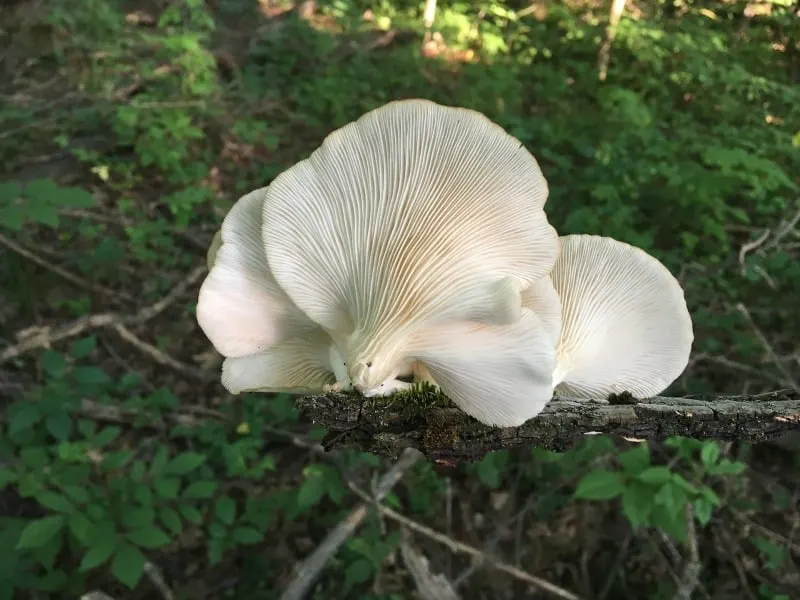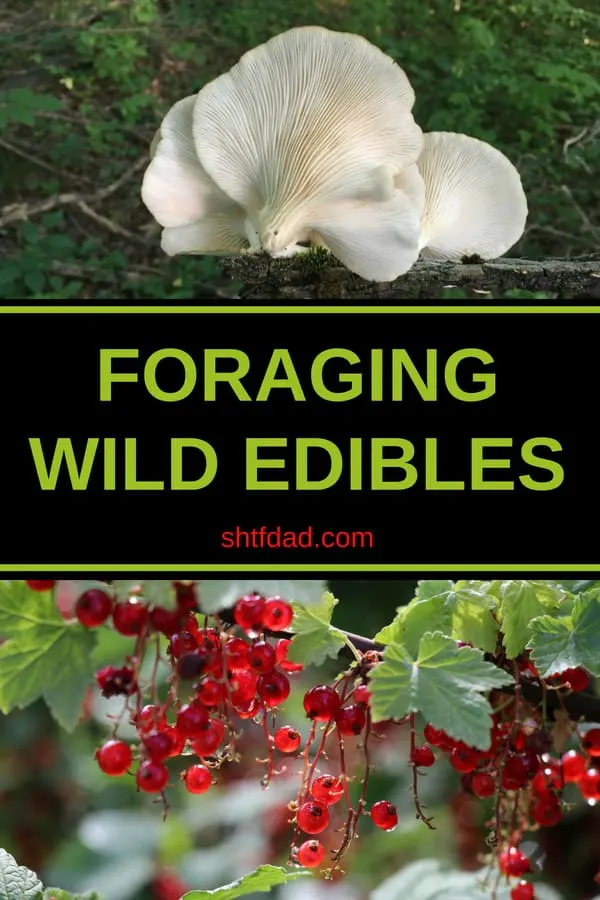SHTFDad may collect a share of sales or other compensation from the links on this page.
Unless you’re living in the middle of the desert, there is a very good chance that the natural habitat around your home is abundantly stocked with wild foods just waiting to be harvested.
Here’s a look at foraging wild edibles: learn about the most popular foods you can forage.
What Is Foraging?

Foraging is the process of going out into that “wild” to gather available foods. By “wild” it should be stressed that it can also mean your backyard:
- weeds in your garden
- the woods behind your house
- natural areas around the nearest lake or river
You may have heard the term “hunter-gatherer” – a term that describes many native people living in various lands.
Most indigenous people spent a good portion of their days hunting large game if available, trapping and fishing other small animals, and gathering fresh seasonal foods in their immediate environment.
Still, other tribes would follow their food as the seasons changed, moving closer to areas where the game and vegetation were more abundant throughout the year.
Nowadays, the kinds of foods people forage depend on their tastes, temperament, and availability in their natural environment.
In the U.S.A. many people forage and consume a variety of natural foods; nuts, seeds, fruits, berries, roots, greens, mushrooms, and other medicinal plants and herbs.
- Vorderbruggen, Mark (Author)
- English (Publication Language)
- 224 Pages - 04/12/2016 (Publication Date) - Alpha...
Foraging Wild Edibles – Most Popular Foods to Forage
Here is a quick list of the most popular foods to forage.
1. Flowers
- Roberts, Margaret (Author)
- English (Publication Language)
- 224 Pages - 05/15/2014 (Publication Date) - Random...
One thing to keep in mind about flowers is that the pollen can sometimes detract from the taste, and may even trigger an allergic reaction in some people.
You may want to consider removing the pistils and stamens leaving only the petals, before eating. Also, introduce them into your diet gradually to avoid exacerbating your allergies.
It’s best to eat flowers you’ve grown yourself so that you know what soil they’ve grown in and what, if anything, may have been sprayed on them. Flowers purchased from a florist or nursery may be unsafe to eat because they’ve been treated with pesticides or other chemicals.
Similarly, don’t eat roadside flowers or those picked from public parks. It’s likely that they have been treated with pesticides or herbicides. Flowers found on the side of the road will have been contaminated by car exhaust and other carcinogenic pollutants.
There are dozens of flowers you can eat. Some of the most common flowers and blossoms include all varieties of Squash, Chamomile, Citrus, Cilantro, Hibiscus, Jasmine, Mint, Rose, Rosemary, and Violets.
They can also be added to salads and desserts for color, fragrance, and whimsy.
You can keep flowers fresh by placing them on top of moistened paper towels in a covered airtight container and refrigerating for up to 10 days. If your flowers go limp, you can also revitalize them with ice water.
2. Nuts and Seeds
Nuts are technically the hard fruits of a tree or bush. They have varying seasons when they can be found. Seeds are also only to be found in the post-harvest season when plants are allowed to prepare themselves for replication. All seeds are found in the fruits or pods of a plant, and some are quite tasty.
In late summer and autumn, some of the more common nuts and seeds to forage include:
- Beechnut
- Hazelnut
- Pine nut
- Walnut
- Poppies
- Sunflower
- Acorns
Acorns, however, require a good amount of soaking and prepping to remove the tannins before eating or being ground into flour. Consult with a local guide or connect with other foragers to learn the tricks of the trade.
3. Berries and Fruit
Berries and fruit are easy to find because they are usually quite large and colorful.
Everything from mulberries to ground cherries is free for the taking. I recommend following local foraging groups in your area so you can stay abreast of the seasons and know what’s available. That way you to go out and gather food before the birds and other animals do.
When foraging, be sure to always leave enough for local wildlife.
Some of the more popular fruits and berries to harvest include:
- Mulberry
- Rose-hips
- Elderberries
- Wild Strawberries
- Blackberries
- Hawthorn Berries
- Crab Apples
- Wild Pears
- Wild Plums
- many more
4. Greens
There are a variety of green leafy plants that taste great fresh in salads or cooked and added to stir fry and stews.
Some of the more common green leafy plants include:
- Lamb’s Quarters
- Dandelion leaves
- Plantain
- Chicory
- Wild lettuce
- Clover
- Nettles
- Woods sorrel
- Sheep sorrel
- Burdock
- Arrow-root
5. Roots and bulbs
Some of the more common wild roots and bulbs include wild carrot and other foods like wild Onion, Leek, Daylilies, Queen Anne’s Lace, and Potatoes.
All of these foods are buried underground and out of sight so you have to know what leaves and flowers look like above ground to find them!
Some medicinal roots, like Valerian, are also used to treat mood disorders and help with sleeplessness.
6. Mushrooms
- Alexander Schwab
- Schwab, Alexander (Author)
- English (Publication Language)
Edible mushrooms can be a great addition to any diet. Hundreds of wild mushrooms are edible, but many others can make you very ill, or even kill you – so be sure to never pick or eat a mushroom that you are not 100% certain you’ve identified correctly.
Some mushrooms can be found year-round, but most mushrooms are most easily tracked down in the damp seasons – late winter or early spring in many geographical areas.
The best time for mushroom hunting in the Pacific Northwest, for example, is between November and February. In other climates, the mushroom hunting season can start later and continue well into April and May.
Some of the more common edible fungi (and the ones you’ll see mushroom hunters bragging about the most when they bring home a huge haul) are:
- Morels
- Puffballs
- Oyster mushrooms
- Chanterelles
- Boletes
- Chicken mushrooms
7. Medicinal Plants
Due to their nutrient-dense properties, many of the wild foods already listed are also potent medicinal plants with specific properties that heal and soothe a variety of ailments.
These plants and medicinal weeds, with their leaves, flowers, roots, and seeds, can be consumed raw, cooked, steeped in tea, infused, pressed for oil and made into tinctures.
Volumes upon volumes have been written on the simple benefits of plant-based medicines. Consult an herbalist, or read, research and experiment before treating yourself with wild plants.
Some plants are dangerous if consumed in large quantities, but can be used to treat intestinal parasites, or as an expectorant if used in small quantities.
Some of the more notable (and safer) wild weeds with medicinal properties include:
- Mallo
- Mullein
- Bee Balm
- Black seed
- Korean mint
- Alfalfa, Catnip
- St. Johns Wart
- Cannabis
- Sage
- Greenthread
- Lemon balm
- and hundreds of other plants
No matter what your taste or climate there are wild natural foods available for harvesting. I recommend teaming up with other experienced foragers to learn which plants are safe, and which to avoid.
Also, invest in a few detailed field guides to help you identify plants out in the wild.
If you plan a day trip or hike, also invest in a small first aid kit, and learn the plants that can be used as antidotes for irritating plants like poison oak, poison ivy, and stinging nettles (Jewel Weed by the way) first and foremost. With practice, it does get easier.
Once you know what’s safe and what’s not, you can share that knowledge with others and encourage people to eat from the wild abundance around us.

Resources:




